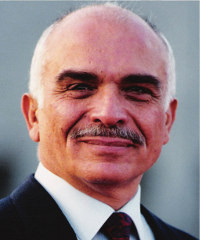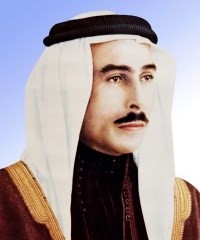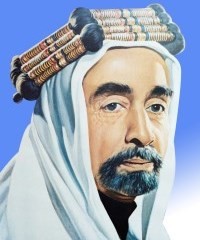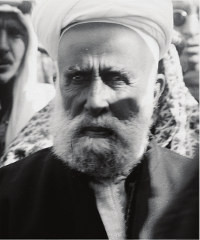The Hashemites have ruled in Jordan since 1921 after the Great Arab Revolt, the lineage has proceeded as follows:
- Al Shareef Hussein Bin Ali, Emir of Mecca, King of the Hijaz and King of the Arabs
- His Majesty King Abdullah I, Emir of Transjordan 1921-1946, King of the Hashemite Kingdom of Jordan 1946-1951
- His Majesty King Talal, King of the Hashemite Kingdom of Jordan 1951-1952
- His Majesty King Al Hussein, King of the Hashemite Kingdom of Jordan 1952-1999
- His Majesty King Abdullah II, King of the Hashemite Kingdom of Jordan 1999 to present
-
1999 - Present
King Abdullah II
 The 41st-generation direct descendant of the Prophet Mohammad (peace be upon him), His Majesty King Abdullah II assumed his constitutional powers as monarch on 7 February 1999.
The 41st-generation direct descendant of the Prophet Mohammad (peace be upon him), His Majesty King Abdullah II assumed his constitutional powers as monarch on 7 February 1999.
Following the leadership legacy of his father, the late King Hussein, King Abdullah II has made the welfare of Jordan’s people the cornerstone of his policies for national development, regional peace and global coexistence. The King’s special concern for the future of Jordan’s young people has put youth engagement, education and opportunity at the top of his agenda. At home, he has paired economic reforms with political liberalization and an innovative program of national development. He has overseen sweeping educational reforms, which today are energizing Jordan's private sector and preparing Jordan's youth for global competitiveness and leadership.
His Majesty King Abdullah II ibn Al Hussein married Queen Rania on June 10th, 1993. The Royal Couple has two sons Crown Prince Al Hussein, born on June 28th, 1994, and Prince Hashem, born on January 30th 2005 and two daughters Princess Iman, born on September 27th, 1996, and Princess Salma, born on September 26th, 2000. -
1952 - 1999
King Hussein
 King Hussein assumed his constitutional powers on May 2, 1953, after reaching the age of eighteen according to the Muslim calendar. During the nine months between his coronation and the assumption of powers, King Hussein’s mother Queen Zein Al-Sharaf played an important role in ensuring the orderly transfer of power as head of a Regency Council.
King Hussein assumed his constitutional powers on May 2, 1953, after reaching the age of eighteen according to the Muslim calendar. During the nine months between his coronation and the assumption of powers, King Hussein’s mother Queen Zein Al-Sharaf played an important role in ensuring the orderly transfer of power as head of a Regency Council.
Queen Zein, who remained ever popular with the people of Jordan, passed away on April 26, 1994. The passing away of His Majesty King Hussein on February 7, 1999 marks the end of an era in Jordan's history.
While the country, and indeed much of the world, mourns the death of King Hussein, Jordanians look with optimism and pride to a future under the reign of King Abdullah II, eldest son of the late King Hussein and current bearer of the Hashemite torch. -
1951 - 1952
King Talal
 After King Abdullah’s martyrdom, King Talal, his eldest son, ruled for a brief period. Due to King Talal’s illness, his eldest son, Hussein, was proclaimed King of the Hashemite Kingdom of Jordan on August 11, 1952.
After King Abdullah’s martyrdom, King Talal, his eldest son, ruled for a brief period. Due to King Talal’s illness, his eldest son, Hussein, was proclaimed King of the Hashemite Kingdom of Jordan on August 11, 1952.
Although King Talal’s reign was short, he introduced a liberalized constitution for the Kingdom that made the government more responsible to the parliament and paved the way for future political development. -
1921 - 1951
King Abdullah I (Founder of Jordan)
 The Emirate of Transjordan was founded on April 11, 1921, and became the Hashemite Kingdom of Jordan upon formal independence from Britain in 1946. During his thirty-year reign, King Abdullah presided over the forging of a viable and durable state out of a tribal, nomadic society. He developed the institutional foundations of modern Jordan, establishing democratic legitimacy by promulgating Jordan’s first Organic Law in 1928 (the basis for today’s Constitution), and holding elections for its first assembly in 1929. While guiding Jordan’s development into a modern state, King Abdullah negotiated a series of treaties with Britain which earned increasing freedom for Jordan. King Abdullah achieved full independence from Britain on May 25, 1946.
The Emirate of Transjordan was founded on April 11, 1921, and became the Hashemite Kingdom of Jordan upon formal independence from Britain in 1946. During his thirty-year reign, King Abdullah presided over the forging of a viable and durable state out of a tribal, nomadic society. He developed the institutional foundations of modern Jordan, establishing democratic legitimacy by promulgating Jordan’s first Organic Law in 1928 (the basis for today’s Constitution), and holding elections for its first assembly in 1929. While guiding Jordan’s development into a modern state, King Abdullah negotiated a series of treaties with Britain which earned increasing freedom for Jordan. King Abdullah achieved full independence from Britain on May 25, 1946.
After successfully defending Arab East Jerusalem and the “West Bank” during the 1948 Arab-Israeli War, King Abdullah regularly travelled to Al-Aqsa Mosque in Jerusalem to participate in the Friday prayers. On July 20, 1951, King Abdullah was assassinated by a lone gunman while attending the Friday prayers there with his grandson Hussein, who was saved from a bullet by a medal his grandfather had recently awarded him. -
1916 - 1924
Sharif Hussein (Leader of the Great Arab Revolt)
 During the Great Arab Revolt of 1916, King Hussein’s great-grandfather, Al-Hussein bin Ali, Sharif of Mecca and King of the Arabs (later he also became known as King of the Hijaz), led the liberation of Arab lands from their domination by the Ottoman Turks.
During the Great Arab Revolt of 1916, King Hussein’s great-grandfather, Al-Hussein bin Ali, Sharif of Mecca and King of the Arabs (later he also became known as King of the Hijaz), led the liberation of Arab lands from their domination by the Ottoman Turks.
After freeing the lands of Jordan, Lebanon, Palestine, Iraq, Syria and the Hijaz, Sharif Hussein’s son Abdullah assumed the throne of TransJordan and his second son Faisal assumed the throne of Syria and later Iraq.
